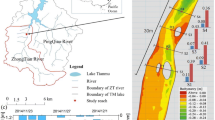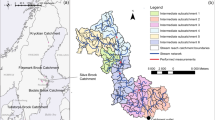Abstract
The hyporheic zone is a region beneath and alongside a stream, river, or lake bed where shallow groundwater and surface water mix. Field and experimental observations, along with modeling studies, indicate that hyporheic exchange occurs mainly in response to pressure gradients driven by the geomorphological features of stream beds. Flow over a pool-riffle sequence creates an irregular pressure gradient that drives hyporheic exchange. Currently to analyze the overall flow pattern in different types of pool-riffle structures, hyporheic exchange flow was analyzed using a fully coupled hydro-dynamic model. Simulation results showed that recirculation zones and stagnation points in the pool-riffle structures dominantly controlled the upwelling and downwelling patterns. Numerical simulations were analyzed for the velocity distribution, velocity vectors, and the streamline and flux of groundwater and surface water. Upwelling flow was dominated by a pressure gradient generated by the apex of riffles. Downwelling flow patterns were affected by the flow pattern formed in pools, which was related to the geometric shapes of the pools. The mixing pattern in the groundwater was also affected by the pool shape. The results will be applicable for river restoration projects and stream ecology related to hyporheic exchange, in the prediction and management of upwelling and downwelling flow induced by bed forms.








Similar content being viewed by others
References
Anderson JK, Wondzell SM, Gooseff MN, Haggerty R (2005) Patterns in stream longitudinal profiles and implications for hyporheic exchange flow at the HJ Andrews experimental forest. Hydrol Proc 19(15):2931–2949
Angermann L, Lewandowski J, Fleckenstein JH, Nutzmann G (2012) A 3D analysis algorithm to improve interpretation of heat pulse sensor results for the determination of small-scale flow directions and velocities in the hyporheic zone. J Hydrol 475:1–11. doi:10.1016/j.jhydrol.2012.06.050
Baxter CV, Hauer FR (2000) Geomorphology, hyporheic exchange, and selection of spawning habitat by bull trout (Salvelinus confluentus). Can J Fish Aquat Sci 57(7):1470–1481
Brunke M, Gonser T (1997) The ecological significance of exchange processes between rivers and groundwater. Freshwater Biol 37:1–33
Cardenas MB, Wilson JL (2006) The influence of ambient groundwater discharge on hyporheic zones induced by current–bedform interactions. J Hydrol 331:103–109
Cardenas MB, Wilson JL (2007) Hydrodynamics of coupled flow above and below a sediment–water interface with triangular bedforms. Adv Water Resour 30(3):301–313
Elliott AH (1990) Transfer of solutes into and out of streambeds. Dissertation, California Institute of Technology
Elliott AH, Brooks NH (1997a) Transfer of nonsorbing solutes to a streambed with bed forms: laboratory experiments. Water Resour Res 33:137–151
Elliott AH, Brooks NH (1997b) Transfer of nonsorbing solutes to a streambed with bed forms: theory. Water Resour Res 33:123–136
Endreny TL, Lautz L, Siegel DI (2011) Hyporheic flow path response to hydraulic jumps at river steps: flume and hydrodynamic models. Water Resour Res 47:W02517. doi:10.1029/2009WR008631
Fox A, Boano F, Arnon S (2014) Impact of losing and gaining streamflow conditions on hyporheic exchange fluxes induced by dune-shaped bed forms. Water Resour Res 50:1895–1907. doi:10.1002/2013WR014668
Franken RJM, Storey RG, Williams DD (2001) Biological, chemical and physical characteristics of downwelling and upwelling zones in the hyporheic zone of a north-temperate stream. Hydrobiologia 444:183–195
Hester ET, Doyle MW (2008) In-stream geomorphic structures as drivers of hyporheic exchange. Water Resour Res 44:W03417. doi:10.1029/2006WR005810
Hester ET, Gooseff MN (2010) Moving beyond the banks: hyporheic restoration is fundamental to restoring ecological services and functions of streams. Environ Sci Technol 44(5):1521–1525
Hester ET, Doyle MW, Poole GC (2009) The influence of in-stream structures on summer water temperatures via induced hyporheic exchange. Limnol Oceanogr 54(1):355–367
Hirt CW, Nichols BD (1981) Volume of fluid (VOF) method for the dynamics of free boundaries. J Comput Phys 39(1):201–225
Huettel M, Webster IT (2001) Porewater flow in permeable sediments. In: Boudreau BP, Jorgensen BB (eds) Transport processes and biogeochemistry: the benthic boundary layer. Oxford University Press, Oxford, pp 144–179
Janssen F, Cardenas MB, Sawyer AH, Dammrich T, Krietsch J, de Beer D (2012) A comparative experimental and multiphysics computational fluid dynamics study of coupled surface-subsurface flow in bed forms. Water Resour Res 48:W08514. doi:10.1029/2012WR011982
Krause F, Boano F, Cuthbert MO, Fleckenstrain JH, Lewandowski J (2014) Understanding process dynamics at aquifer–surface water interfaces: an introduction to the special section on new modeling approaches and novel experimental technologies. Water Resour Res 50:1847–1855. doi:10.1002/2013WR014755
Orghidan T (1959) Ein neuer lebensraum des unterirdischen wassers: der hyporheische biotop. Arch für Hydrobiol 55:392–414
Rodríguez JF, Garcia MH, Bombardelli FA, Guzman JM, Rhoads BL, Herricks EE (2000) Naturalization of urban streams using in-channel structures. In: 2000 Joint conference on water resources engineering and water resources planning and management
Salehin MA, Packman I, Paradis M (2004) Hyporheic exchange with heterogeneous streambeds: laboratory experiments and modeling. Water Resour Res 40:W11504. doi:10.1029/2003WR002567
Savant SA, Reible DD, Thibodeaux LJ (1987) Convective transport within stable river sediments. Water Resour Res 23:1763–1768
Thibodeaux LJ, Boyle JD (1987) Bedform-generated convective transport in bottom sediment. Nature 325:341–343
Tonina D, Buffington JM (2007) Hyporheic exchange in gravel bed rivers with pool-riffle morphology: laboratory experiments and three dimensional modeling. Water Resour Res 43:W01421. doi:10.1029/2005WR004328
Tonina D, Buffington JM (2009) A three-dimensional model for analyzing the effects of salmon redds on hyporheic exchange and egg pocket habitat. Can J Fish Aquat Sci 66:2157–2173
Trauth N, Schmidt C, Maier U, Vieweg M, Fleckenstein JH (2013) Coupled 3-D stream flow and hyporheic flow model under varying stream and ambient groundwater flow conditions in a pool-riffle system. Water Resour Res 49:5834–5850. doi:10.1002/wrcr.20442
Zarnetske JP, Haggerty R, Wondzell SM, Baker MA (2011) Dynamics of nitrate production and removal as a function of residence time in the hyporheic zone. J Geophys Res 116:G01025. doi:10.1029/2010jg001356
Acknowledgments
This study was supported by the Center for Aquatic Ecosystem Restoration (CAER) of Eco-STAR project from Ministry of Environment, Republic of Korea (MOE; EW12-07-10).
Author information
Authors and Affiliations
Corresponding author
Rights and permissions
About this article
Cite this article
Lee, D.H., Kim, Y.J. & Lee, S. Numerical modeling of bed form induced hyporheic exchange. Paddy Water Environ 12 (Suppl 1), 89–97 (2014). https://doi.org/10.1007/s10333-014-0449-8
Received:
Revised:
Accepted:
Published:
Issue Date:
DOI: https://doi.org/10.1007/s10333-014-0449-8




